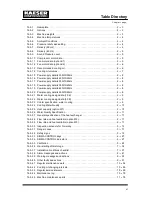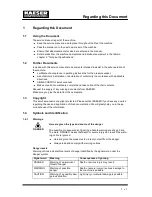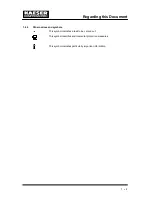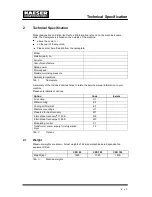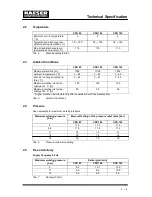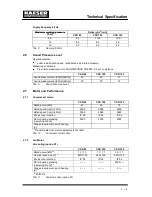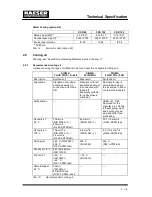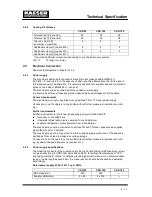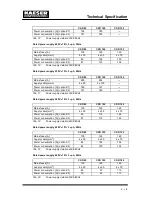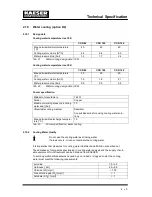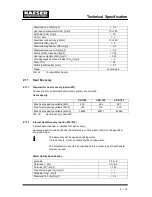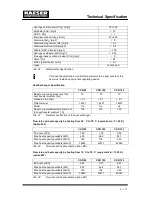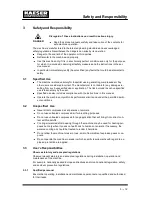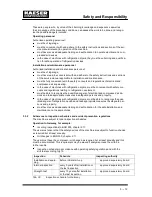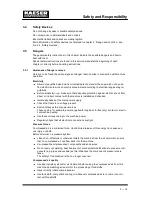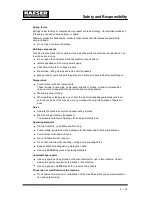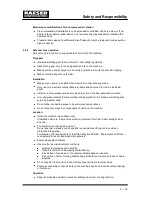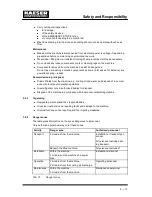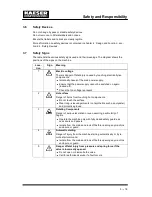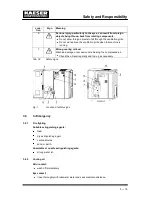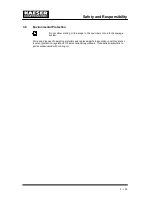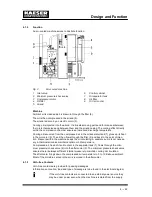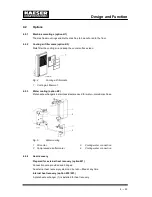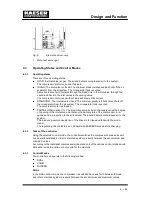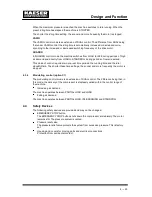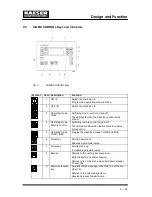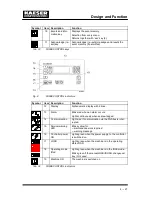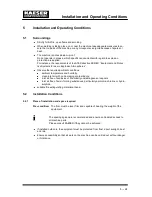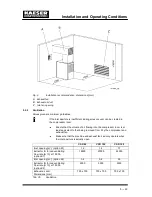
Safety and Responsibility
3 --- 14
3.4
Safety Devices
Do not change, bypass or disable safety devices.
Do not remove or obliterate labels and notices.
Ensure that labels and notices are clearly legible.
More information on safety devices is contained in chapter 4 ’Design and Function’, sec-
tion 4.4 ’Safety Devices’.
3.5
Dangers
The general safety instructions in this chapter indicate the possible dangers and how to
deal with them.
Special safety instructions are found in this service manual at the beginning of each
chapter or directly before handling instructions.
3.5.1
Awareness of danger sources
Here are to be found the various types of danger that can arise in connection with machine
operation.
Electricity
Allow only qualified electricians or trained personnel under the supervision of a quali-
fied electrician to work on electrical equipment according to electrical engineering re-
gulations.
Before initial start ---up, make sure that adequate protection against electric shock from
direct or indirect contact with the machine is installed and checked.
Isolate all phases of the main power supply.
Check that there is no voltage present.
Switch off any external power sources.
These can be, for example, power supplied through a volt ---free (dry) contact or electri-
cal machine heating.
Use fuses corresponding to the machine power.
Regularly check that all electrical connections are tight.
Pressure forces
Compressed air is a contained force. Uncontrolled release of this energy can cause seri-
ous injury or death.
Before all work on a pressure system:
close shut ---off valves or otherwise isolate the machine from the air network to ensure
that no compressed air can flow back into the machine,
de---pressurize all pressurized components and enclosures.
Do not carry out welding, heat treatment or mechanical modifications to pressure com-
ponents (e.g. pipes and vessels) as this influences the component’s pressure resis-
tance.
The safety of the machine is then no longer ensured.
Compressed air quality
Use appropriate systems for air treatment before using the compressed air from this
machine as breathing air and/or for the processing of foodstuffs.
Never directly inhale compressed air.
Use foodstuff---compatible cooling oil whenever compressed air is to come into con-
tact with foodstuffs.
Summary of Contents for CSD 102
Page 2: ......
Page 85: ......
Page 86: ......
Page 87: ......
Page 88: ......
Page 89: ......
Page 90: ......
Page 95: ......
Page 96: ......
Page 97: ......
Page 98: ......
Page 99: ......
Page 100: ...Appendix 13 92 13 1 2 Pipeline and instrument flow diagram option C1...
Page 101: ......
Page 102: ......
Page 103: ......
Page 104: ......
Page 105: ......
Page 106: ...Appendix 13 98 13 1 3 Dimensional drawing 13 1 3 1 Air cooling option K1...
Page 107: ......
Page 108: ......
Page 109: ...Appendix 13 101 13 1 3 2 Water cooling option K2...
Page 110: ......
Page 111: ......
Page 112: ...Appendix 13 104 13 1 4 Electrical diagram...
Page 113: ......
Page 114: ......
Page 115: ......
Page 116: ......
Page 117: ......
Page 118: ......
Page 119: ......
Page 120: ......
Page 121: ......
Page 122: ......
Page 123: ......
Page 124: ......
Page 125: ......
Page 126: ......
Page 127: ......
Page 128: ......
Page 129: ......
Page 130: ......
Page 131: ......
Page 132: ......
Page 133: ......
Page 134: ......

